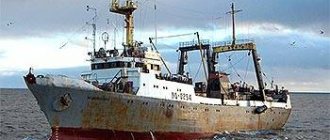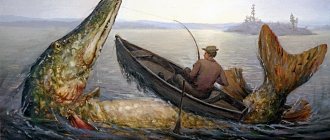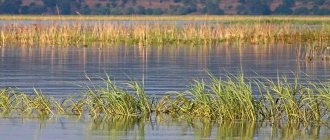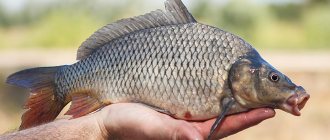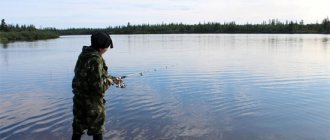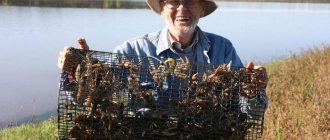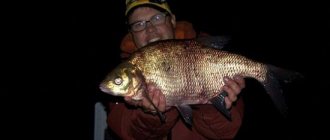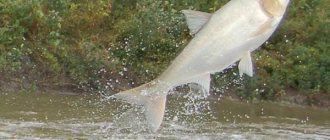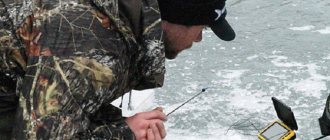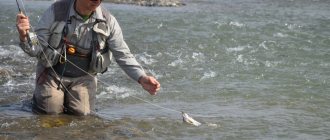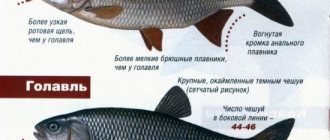What does bream like to eat?
Bream, being endowed with a good sense of smell, is picky about food. In search of food, he stretches his lips into a tube and, having filled his mouth full of water, throws it into the silt with an intense stream - in the washed-out silt it is easier to pick up water larvae.
In addition to the above, the “products” that bream prefers include:
- young shoots of algae;
- worms;
- slugs;
- crustaceans;
- bloodworm.
Bream has the best appetite at a water temperature of 15 to 20 degrees.
How to find large bream in a pond - signs
The path along which the bream moves can be easily calculated by the small bubbles, which makes it easy to determine the habitat of the bream.
It also blows bubbles when it digs through the silt at the bottom of a reservoir. And the smacking sound that the bream makes while sucking the slugs stuck to the bottom of the algae leaves gives it away.
In addition, its habitat can be determined by the play of the fish both at morning and evening dawns - the bream absolutely silently floats to the water surface, after which it shows its muzzle, dorsal fin, and that’s what it was - it goes back to the depths.
But the bream leaves a trace of its recent presence in the form of an obligatory diverging circle. Bream act similarly on cloudy or hot days, as well as on the eve of a thunderstorm.
5+5 tricky fishing tips from experienced fishermen!
Features of complementary feeding
A special feature of bream is their love for tasty and plentiful food. In closed reservoirs, these fish tend to change their parking places. However, they never ignore feeding areas.
Bream is cunning and cautious, so it is fed in the chosen place for about a week, but not less than 5 days. In this case, the bait is laid at a depth of three meters. Bream avoids shallow water, and there is a high probability of smaller fish eating the bait here.
We recommend reading: Catching perch with a balance beam in winter
So what does bream bite best on? The best bait is blizzard larvae, dung worms, maggots and blizzard larvae. In addition to the above, attachments made from dough with eggs, semolina porridge and peas (steamed) are also effective. It is recommended to use a No. 5 hook and give the dough stuck to it a pear shape.
Worms and maggots should be placed on the hook in a lump or in clusters. At the same time, it is unacceptable to leave even a small section of the hook open, since bream is sensitive to the smell of metal.
Two important conditions for successful bream fishing are a flexible rod and the location of the bait at the bottom of the reservoir. Flat bream bites like this: it stands upright and sucks in the bait simultaneously with the river water. The external sign of a bite is this: the float first lies on the water and then begins to sink.
When to catch bream
Although bream is caught all year round, there is an exception - small breaks during the period when the reservoir is freed from ice or, conversely, during its formation.
And as soon as the reservoir is freed from the shackles of ice, bream can be caught. And even though the pre-spawning bite is a short-lived phenomenon, fishing nevertheless promises to be fruitful - the bream will get pretty hungry during the winter.
The most successful fishing is that which is carried out from the evening, just before dusk until early morning, in the period before sunrise.
Therefore, night fishing is a great idea for those who like to eat bream. At night, as a rule, the most trophy specimens are caught. But provided that the night is warm and windless.
But in some cases, the bite happens at 10-11 o’clock in the morning - this is possible in clear weather, but with a moderate breeze.
Bait for bream
When fishing for bream, bait is the most important thing. If you feed your fishing spot correctly, the bream will not keep you waiting long - the bites will follow one after another!
Specialized shops for fishermen offer a good range of bait - both universal and for a specific type of fish.
However, experienced fishermen recommend paying tribute to the bait for bream, made independently. In essence, bream eats almost all types of food, regardless of its origin - animal or plant.
But! If the reservoir is rich in delicacies, the bream will prefer them. However, there is a list of ingredients that bream is partial to:
- corn kernels;
- rolled oats;
- cereals: millet and rice;
- peas;
- bran (any);
- worms: dung and earthworms.
It should be borne in mind that bream does not bite at all during a sharp drop or rise of water in the reservoir, as well as even with the slightest increase in its level.
Useful and interesting: Four homemade bream bait recipes that are great for attracting fish!
Lure
There will be no successful bream fishing without baiting and baiting. Establishing a fishing spot should be done a few days before the fishing session, allowing the object of the hunt to get used to the smell of the food and make sure that the feeding spot is safe. Bait for attaching and directly feeding fish at the time of fishing is made according to the same recipe.
Methods of catching bream are based on the concentration of fish at a certain point, which can be done with bait that reaches the bottom and only then scatters over a certain zone, thus creating a contrasting spot different from the color of the bottom sediments. To obtain such qualities, the composition of the bait includes soil from chernozem and dried loam. The base of the mixtures is prepared from boiled millet or pearl barley porridge, adding pureed steamed peas and sunflower cake, bringing the composition to a thick and sticky consistency. To give the effect of dusting in water, complementary foods are supplemented with breadcrumbs and a small amount of mashed white bread crumb is included in the composition.
It is advisable to use natural ingredients as attractants, which include:
- table salt;
- sugar;
- cumin, anise or camphor oil;
- valerian;
- young, unthickened honey.
One of the latest discoveries of the bream fish was finding out the secret of how fish show interest in the smell of coffee. Coffee cake obtained as a result of preparing the drink in coffee machines has become an excellent additive in complementary foods that collect bream at the fishing point.
Important! The supply of complementary food is carried out by the formation of hard balls the size of an orange, compressed with such force that will allow the mixture to reach the bottom and only begin its destruction as a result of hitting the ground.
Tackle for catching bream - what to fish with
Bream is a very cautious fish. Therefore, to catch it, you should select a more delicate tackle - coarse gear is useless when catching bream. Knowing the habits of this fish, you should take a thinner line and a hook so that it is not visible (let it be hidden in the bait).
When fishing for bream, I prefer a line with a diameter of 0.2 mm, with a leader thinner than the base of the line - 0.15 mm. And the hook is suitable for such tackle - number 5 or 6.
There are also various catchy homemade products with which the catch of bream increases significantly, for example, catching bream with a rocker or with a ring (with “eggs”).
Or a newfangled trend - feeder fishing. In short, fishing with a feeder involves fishing with the same gear as with a float, only the fishing rod is additionally equipped with a feeder into which bait is placed.
But this is a separate topic, which I will share with you in future publications.
Basic fishing methods
Winter gear
Rocker
A simple and quite effective method of winter fishing for bream. The tackle has many advantages over others, namely:
- Large and cautious fish are caught on the yoke.
- Significantly unloads the gear.
- Makes it possible to catch bream at the bottom of a muddy pond, where a jig or sinker is useless.
Mormyshka
The jig for winter fishing is:
- motionless,
- playing.
In a stationary jig, the main role is played by the nod.
It plays the role of a signaling device instead of a float. The fishing rod must be placed above the hole so that the nod bends under the weight of the jig, and the jig itself should only touch the bottom. The playing jig works on the fish's reaction to the movement of objects. The small oscillating body creates local currents that the bream catches. Thus, the movement of living organisms is imitated, inducing the fish to bite.
Float rod
There are 2 types of float rod for winter fishing for bream:
- for standing water,
- for the current.
The winter fishing rod is equipped with:
- fishing rod,
- fishing line,
- crochet,
- sinker,
- float
You can buy a fishing rod in the store, or you can make it yourself.
A convenient fishing rod for winter is one with a wooden pencil case handle, a reel and a stand in the form of legs.
Shore fishing in open water
- Feeder . In order to catch bream on a feeder, you need to choose the right place. This place is located between the strong and small currents of a reservoir or river. It is good to fish with a feeder near holes 3-5 m deep. The feeder rod should be strong and flexible, a fishing line 0.14 mm thick, two leashes 0.08-0.1. The length of the leash is 25-50 cm, with equipment 30-60 cm, hook size 4-6 for corn, 8-12 for a sandwich of bloodworms and maggots.
- Rubber. Fishing with a rubber band is simple and effective. The rubber bottom tackle consists of the following elements:
- Loading the gum.
The rubber itself.
- Leashes and hooks.
- Float tackle. The most common tackle for catching bream. It must be strong and durable, and it must be thrown far. Acceptable length is 4-4.5 m.
- A pole rod is the most effective tackle, but fly rods and mast rods are also suitable. The main thing is that the bait gets to the right place. The bream does not really resist when it gets hooked, so there is no point in using strong carp tackle.
- Donka. With the help of a donkey, you can catch bream in windy weather and in bad weather, when it hides in the depths. An ordinary fishing rod is useless here. There are many varieties of donks, but the following elements are mainly present:
- rod,
- fishing line,
- spring,
- leash,
- hook,
- sinker.
An ordinary donka with a rubber shock absorber showed itself to be a very catchy tackle.
They are caught mainly in stagnant lakes, from the shore, and rarely from a boat. A stick is stuck on the river bank, a cut is made in the middle into which a fishing line is attached.
coil,
There is nothing complicated, everything is simple, any element is sold in the store. The main thing is to properly equip the donk depending on the fishing location.
Fishing from a boat
Fishing from a boat with a strong current using a ring has proven itself well .
The ring is made of lead, round; it is replaced by an ordinary washer. The length of the fishing rod is small, 0.7 m, between the hooks there should be approximately 0.5 m.
The boat is equipped with 2 anchors, a net for feeding, and the tackle itself. The signal is a nod with a bell.
To better feel the bite of a fish, many fishermen wrap the fishing line around their fingers. The boat is anchored 20-30 m above the found flock.
